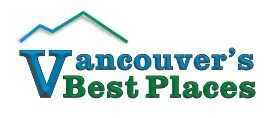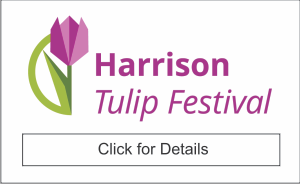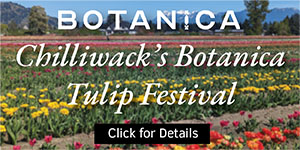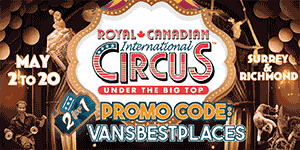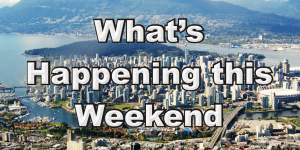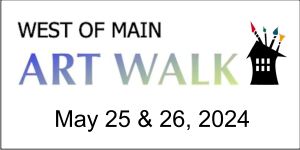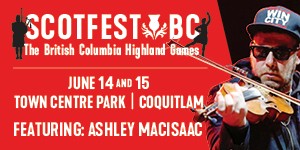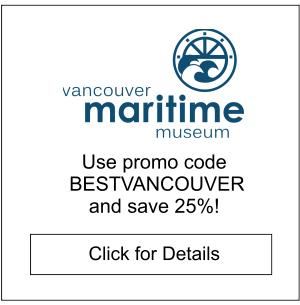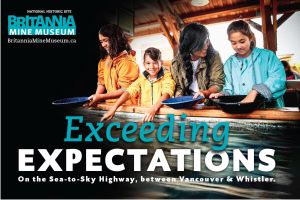
The Great Blue Heron Nature Reserve is a great spot in Chilliwack to see birds and other wildlife. It’s also a nice place for leisurely walks.
The Fraser Valley Nature Reserve on the Vedder River
Herons aren’t the only creatures that love the Great Blue Heron Nature Reserve. It’s a popular area for people and other wildlife too.
The place has a main building with a small gift shop, animal displays and an information desk. The building is the Rotary Interpretive Centre. It also has a room where they run workshops, including painting classes and summer camp activities. The facility is open almost every day of the year. About once a month or so they offer tours around the trails of the reserve.
When the building is open there are volunteers who’ll answer questions and help you with your gift shop purchases. They also have bird books, so if you see something and you’re wondering what it was, they might be able to help you.
Inside the building there are public washrooms with flush toilets. Outside there are outhouses. The reserve has a fair amount of parking. They lock the gates though at night.
The reserve is on the Vedder River, which, interestingly, is a man-made river. The lagoons in the reserve are also man-made. They were built by the military in the 1940s and 50s for bridge-related exercises and other training.
Within the reserve are a couple of lagoons, a forest and some marshland. The trails are mostly hard-packed gravel. In a few places, which are marshy in wetter seasons, there are wooden boardwalks.
The nature reserve is a really nice place, but it isn’t so well known. On the busiest days fewer than 200 visit. On slow days it can be as few as a dozen, or even less on a weekday in the slow season or if the weather is poor.

Blue Heron Reserve Trails
There are a number of trails at the nature reserve. A few are pretty much out in the open, with vegetation at the sides of the path. Other trails are very much in the trees and the brush, with lots of shade, which makes them nice and cool on hotter summer days.
In addition to the trails within the nature reserve, there is a dyke trail that runs right past the place. It’s great for walks and leisurely bike rides. It goes for miles in both directions.
The main trails at the reserve are the Salwein Trail, Tower Trail, Discovery Trail and Heron Colony Trail. Running along the Vedder River is the Vedder Rotary Trail. There is also the Rotary Connector Trail which connects the parking lot area with the Vedder Rotary Trail as well as the Tower Trail in between. And running for miles, all the way to Abbotsford, is the Vedder North Dyke Trail.
Note: Dogs, horses and bicycles are not permitted on the Salwein, Tower, Discovery or Heron Colony trails. They are allowed, however, when on leash, on the Vedder North Dyke Trail, Vedder Rotary Trail and Rotary Trail Connector.

Salwein Creek Trail
We’ve done the Salwein Trail a few times. It’s really nice and takes about 20 minutes to do the full thing. It’s about half a kilometre long and quite out in the open. It gets hot on sunny summer days. The Salwein Trail goes along the northern edge of the North Lagoon and around Salwein Creek. It’s nice because it’s close to water, which is pretty and where birds like to hang out.
To get to the Salwein Trail you just head east from the Rotary Interpretive Centre along the waterfront.
Tower Trail
Tower Trail is about 0.7 km long. It also takes about 20 or so minutes to do, plus a little bit more to get to and from the Rotary Interpretive Centre.
To get to the Tower Trail you cross the bridge near the main building and parking lots and walk just a little ways along the Rotary Connector Trail. Near the entrance to the Tower Trail there is a four-storey tower that you can climb up to see the surrounding area.
The Tower Trail itself is really nice. It has lots of vegetation, so it’s very pretty. Most of the route is also in the shade, which makes it really nice in hot weather. Because there is so much vegetation, however, it can be harder to see the birds. The trail goes around the Cattail Marsh. Part of the trail is hard-packed gravel. There are also sections covered in wood chips. In this area though there are also a few wooden boardwalks. Because they like marshland, there are lots of cottonwood trees in the area.

Discovery Trail
The Discovery Trail also takes 20 minutes or so to walk. The same as the Salwein Creek Trail, it’s also just 0.5 km in length. It’s west of the Rotary Interpretive Centre. You don’t cross the bridge to get to it (although you do cross two bridges on your way back via part of the Heron Colony Loop). By the start of the Discovery Trail is the Education Centre. In the area you might see signs of beaver activities. This also used to be a good area to see the heron colonies, although in recent years they have moved to a different area.
Heron Colony Loop
The Heron Colony Loop is the longest of the trails at the reserve, other than the Vedder Rotary Trail. It’s about 1.2 km in length and takes around 40 minutes to do the full loop. Similar to the Discovery Trail, or even more so, it used to be a great area to see the heron colony and all its nests. The herons have moved further east within the reserve, however, so are no longer so visible in this area.
The Heron Colony Loop goes around the South Lagoon. A section of the trail is sometimes closed from March until July to protect the herons during their nesting season (or at least this used to be the case).
Vedder Rotary Trails
There is both an East Loop and a West Loop on the Vedder Rotary Trail which goes along the Vedder River. To get to the Vedder Rotary Trail you cross the bridge near the Rotary Interpretive Centre and head straight south along the dirt road until you get to the river.
The West Loop is just over 3.5 km and takes about an hour and a half to walk. You can walk along the trail until you get to the Vedder North Dyke Trail. When you reach that trail, head east along it and it’ll take you back to the parking lots and the Rotary Interpretive Centre.
The same as the West Loop, the East Loop is also just over 3 and a half kilometres long and takes about 90 minutes to walk. The East Loop also connects with the Vedder North Dyke Trail which you can go west along to get back to the Great Blue Heron Nature Reserve.

Vedder North Dyke Trail
The Vedder North Dyke Trail isn’t part of the Nature Reserve, but it goes right by it. The trail goes for miles! It’s nice and flat, which makes it a great place for walking and leisurely bike rides.
Herons, Birds and Other Wildlife
There can be up to 100 herons (and 50 nests) in the area. There used to be more, but their numbers have gone down. The best time to see them is in the spring, before the trees get their leaves. That’s when you can see the nests. By late spring and the summer though, the nests get hidden with all the leaves.
Some of the trails have lots of vegetation, which can make it hard to see birds and other wildlife. It’s usually easier to see them in the more open areas, and places close to the water. In a few spots there are viewing shelters, which are walls made of wood with spaces that you can look through. They are there so the birds don’t see you, or at least you aren’t quite so obvious.
In addition to herons and ducks, the reserve is home to lots of other wildlife too. There is a notice board outside the main building with a list of critters and fowl spotted in the previous week. When we were there in July there were bald eagles, turkey vultures, humming birds, woodpeckers, a belted kingfisher and a wide range of other birds on the list.
Animals We’ve Seen
On the list there were also green frogs, bull frogs, beaver, rabbits and coyotes (with the last two including kits and pups). On one of the trails we saw a bobcat, which are quite rare in the area, so the reserve volunteers were able to add that sighting too! We also met a photographer who snapped an eagle with a fish in its beak.
On our visit in the summer we saw a few ducks and a couple of birds. We heard lots of birds, and we saw the bobcat. We didn’t see a lot of wildlife, but the bobcat made up for that. Seeing that was pretty cool! Thank goodness it wasn’t a cougar (which along with bears can occasionally be in the area)! We also saw trees that had been chewed by beavers.
Salmon, Cedar and Water Ceremony
An event that has been happening for over a dozen years is the Salmon, Cedar and Water Ceremony. It takes place at the Great Blue Heron Nature Reserve on January 1st each year. The Indigenous-led event usually begins in the morning at around 11:00 am on New Year’s Day.
At the event, participants walk from the Rotary Interpretive Centre to the edge of the Vedder River. Along the way they stop to reflect at the base of a cedar tree that was planted years ago as an offering to both tobacco and salmon.
The ceremony continues at the river. It honors the salmon, cedar trees and Vedder River. After the ceremony, the group returns to the Great Blue Heron Nature Reserve for food at the Rotary Interpretive Centre.
The Salmon, Cedar and Water Ceremony is free to attend and led by Gracie Kelly of The’wa:li First Nation and Eddie Gardner of the Sqwá First Nation.
New Year’s Day at the Nature Reserve
The Salmon, Cedar and Water Ceremony takes place at the Great Blue Heron Nature Reserve on January 1st most years. Starting at 11:00 am, attendees walk from the reserve to the Vedder River for the ceremony which honors the cedar trees, river and salmon. Led by Gracie Kelly of The’wa:li First Nation and Eddie Gardner of the Sqwá First Nation, the annual event is free to attend. There is no need to register. You can just show up.
After the ceremony at the river, the group usually heads back up the reserve for lunch, which includes some salmon samples.
To learn more about the event, see the article by the Chilliwack Progress newspaper.
Other Information
For more information about the natural attraction, see the Great Blue Heron Nature Reserve’s website.
To learn more about the area, see our articles about Chilliwack and the Fraser Valley.
For the official website of Tourism Chilliwack, visit tourismchilliwack.com.
Other similar places that might be of interest include the following:
- Reifel Bird Sanctuary (in Delta)
- Maplewood Flats (in North Vancouver)
- Camosun Bog (in Vancouver)
Other places that you might like, but that aren’t bird sanctuaries, are the following:
- Chilliwack Museum and Archives
- Minnekhada Park in Coquitlam
- Alouette Greenway in Maple Ridge
- Kanaka Creek in Maple Ridge
- Rolley Lake in Mission
- West Dyke Trail in Richmond
